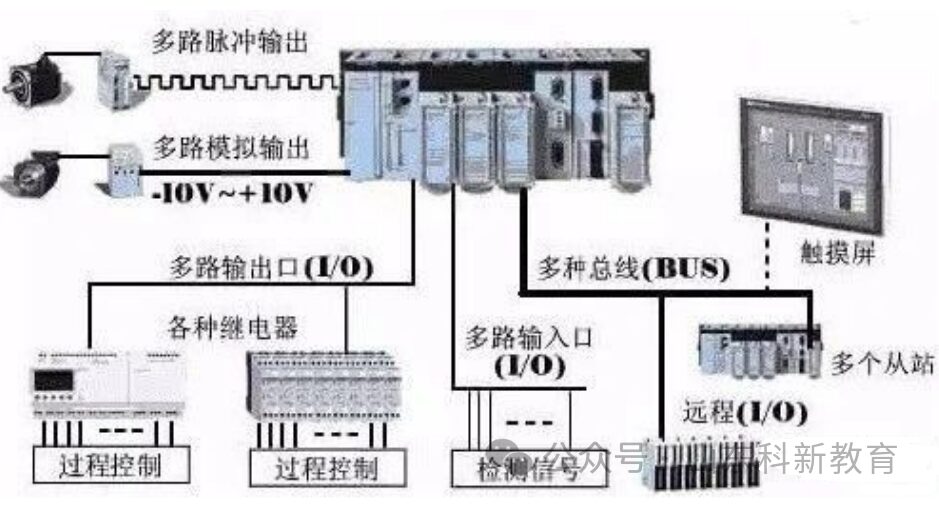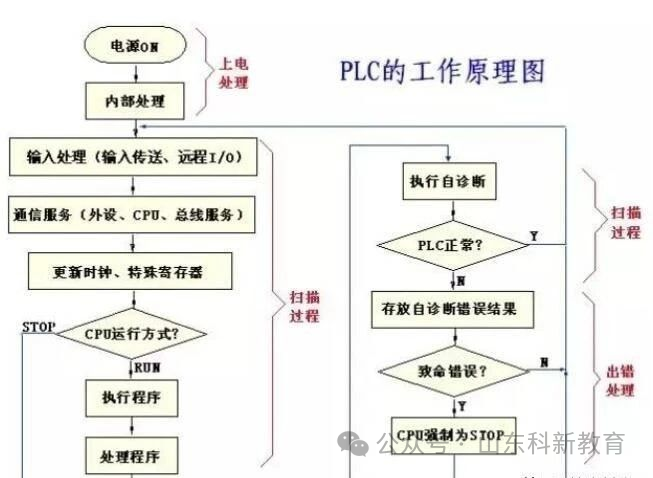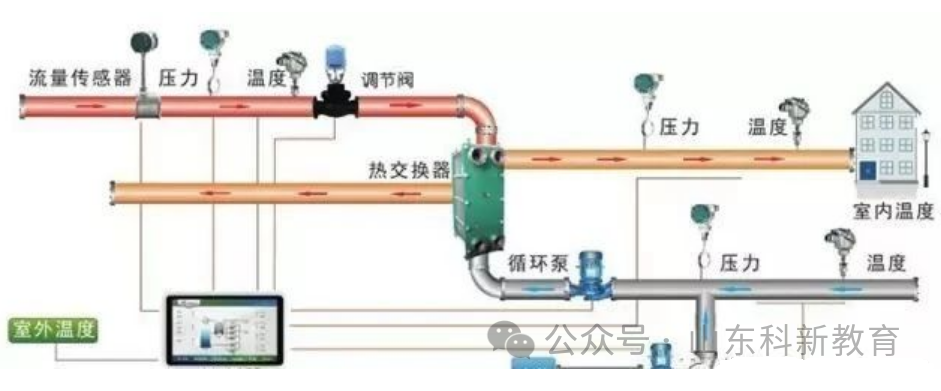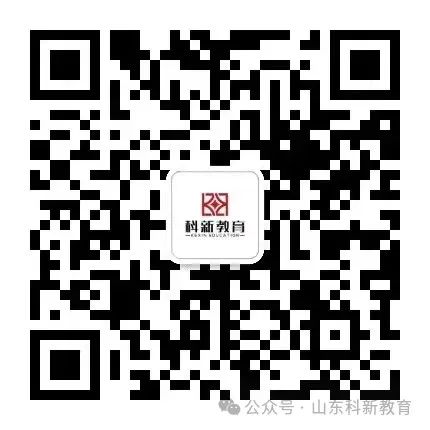

1. Used for Discrete Control

The ability of PLC to control discrete signals is very strong. The number of input and output points can range from a few dozen to several hundred, even thousands or tens of thousands. Because it can be networked, the number of points is almost unlimited, and it can control any number of points. The controlled logic can be diverse: combinational, sequential, instantaneous, delayed, non-counting, counting, fixed order, random operation, etc.
The hardware structure of a PLC is variable, and the software program is programmable, making it very flexible for control. If necessary, multiple sets or groups of programs can be written and called as needed. It is well-suited for the needs of industrial sites with multiple working conditions and state changes.
There are many examples of using PLC for discrete control in metallurgy, machinery, light industry, chemical industry, textiles, etc. Almost all industrial sectors require it. Currently, the primary goal of using PLC, which other controllers cannot compare to, is its ability to conveniently and reliably control discrete signals.
2. Used for Analog Control

Analog signals, such as current, voltage, temperature, pressure, etc., change continuously. In industrial production, especially in continuous production processes, it is often necessary to control these physical quantities.
As an industrial control electronic device, if a PLC cannot control these quantities, it is a significant shortcoming. Therefore, PLC manufacturers are conducting extensive development in this area. Currently, not only large and medium-sized machines can perform analog control, but even small machines can achieve this control. For PLC to perform analog control, it must be equipped with A/D and D/A units that convert between analog and digital signals. These are special I/O units.
The A/D unit converts the external circuit’s analog signal into a digital signal and then sends it to the PLC; the D/A unit converts the PLC’s digital signal back into an analog signal and sends it to the external circuit. As a special I/O unit, it still possesses characteristics such as anti-interference for I/O circuits, isolation between internal and external circuits, and information exchange with input/output relays (or internal relays, which are also a writable area of PLC’s working memory).
In this context, A in A/D usually refers to current or voltage, and sometimes temperature, while A in D/A mostly refers to voltage or current. The voltage and current ranges are typically 0–5V, 0–10V, or 4–20mA, and some can handle both positive and negative values. The D in D/A is often an 8-bit binary number for small machines and a 12-bit binary number for medium and large machines. A/D and D/A can be single-channel or multi-channel, with multi-channel occupying more input/output relays. With A/D and D/A units, the remaining processing is all digital, which is not difficult for a PLC with information processing capabilities. Medium and large PLCs have even stronger processing capabilities, allowing not only basic arithmetic operations but also square roots, interpolation, and floating-point calculations. Some even have PID instructions for proportional, derivative, and integral calculations, thus generating corresponding outputs, making it capable of performing almost all calculations that a computer can perform.
Therefore, it is entirely possible to achieve analog control using PLCs.
Furthermore, PLCs can also have combined A/D and D/A units, and use PID or fuzzy control algorithms to achieve control, resulting in high control quality. The advantage of using PLC for analog control is that while performing analog control, discrete signals can also be controlled. This advantage is not found in other controllers, or their implementation is not as convenient as that of PLCs. However, if the system is purely for analog control, using PLC may not be as cost-effective as using a dedicated regulator.
3. Used for Motion Control

In addition to discrete and analog signals, motion control is another important physical quantity. For instance, the displacement of machine tool components is often represented as a digital quantity. Effective motion control methods include NC, or numerical control technology, which originated in the USA in the 1950s based on computer technology. Today, it is widely used and well-developed.
Currently, in advanced countries, the proportion of numerical control in metal cutting machine tools has exceeded 40% to 80%, with some even higher. PLCs are also based on computer technology and are continually improving. PLCs can receive counting pulses with frequencies ranging from several kHz to tens of kHz, and can receive these pulses in various ways, even from multiple sources. Some PLCs also have pulse output functions, with pulse frequencies reaching tens of kHz. With these two functions, combined with the data processing and calculation capabilities of PLCs, and when equipped with appropriate sensors (such as rotary encoders) or pulse servo devices, various controls can be implemented based on NC principles.
High and mid-range PLCs have also developed NC units or motion units that can achieve point control. Motion units can also implement curve interpolation and control curve movements. Therefore, if a PLC is equipped with such units, it can completely use NC methods for digital control. Newly developed motion units even include programming languages for NC technology, providing convenience for better digital control using PLCs.

4. Used for Data Acquisition

With the development of PLC technology, the data storage capacity has become increasingly large. For instance, the PLC from Devison Company has a data storage area (DM area) that can reach up to 9999 words. Such a vast data storage area can store a large amount of data. Data acquisition can be performed using counters to accumulate the number of pulses collected and periodically transfer them to the DM area. Data acquisition can also use A/D units, where analog signals converted into digital signals are periodically transferred to the DM area. PLCs can also be equipped with small printers to periodically print data from the DM area.
PLCs can also communicate with computers, allowing the computer to read data from the DM area and process it. In this case, the PLC acts as a data terminal for the computer.
Electricity users have previously used PLCs to record real-time electricity usage, enabling different pricing methods based on varying usage times, encouraging users to consume more electricity during off-peak hours to achieve reasonable and energy-saving consumption.
5. Used for Signal Monitoring

PLCs have many self-check signals and numerous internal components, and most users do not fully utilize their capabilities. In fact, they can be used to monitor the PLC’s own operation or the controlled object. For a complex control system, especially an automatic control system, monitoring and even self-diagnosis are very necessary. This can reduce system failures, facilitate fault finding, improve the mean time between failures, reduce repair time, and enhance system reliability.
6. Used for Networking and Communication

PLC has strong networking and communication capabilities, with new network structures continually being introduced.
PLCs can connect with personal computers for communication, allowing computers to participate in programming and manage PLC control, making PLC usage more convenient.
To fully utilize the computer’s capabilities, one computer can control and manage multiple PLCs, with numbers reaching up to 32. A PLC can also communicate with two or more computers, exchanging information to achieve greater monitoring of the PLC control system. PLCs can communicate with each other, whether one-to-one or multiple PLCs, potentially reaching dozens or even hundreds.
PLCs can also connect to smart instruments and smart actuators (such as frequency converters) for networking and data exchange, enabling remote control systems that can extend up to 10 kilometers or more. They can form local networks where not only PLCs but also high-end computers and various smart devices can be integrated. Bus networks or ring networks can be used, and networks can be bridged. Networking can organize thousands of PLCs, computers, and smart devices into one network, allowing direct or indirect communication and information exchange between nodes.
Networking and communication meet the needs of today’s Computer Integrated Manufacturing Systems (CIMS) and intelligent factories. This can integrate industrial control from point, to line, to area, connecting device-level control, production line control, and factory management into a cohesive whole, thereby creating higher efficiency. This infinite and promising future is increasingly clear to our generation.

The above points of application are emphasized qualitatively. Quantitatively, PLCs come in various sizes, so their control range can also vary. Small PLCs may control just one device, or even a single component at one site; larger PLCs can control multiple devices, an entire production line, or even an entire factory. It can be said that PLCs are indispensable in all industrial control scenarios.
Source: This article is reprinted from the internet, and the copyright belongs to the original author. If there are copyright issues, please contact us promptly for removal. Thank you!

Scan to Follow
WeChat ID|13615417996
Follow the QR code on the left for free access to
[Siemens Resource Collection]